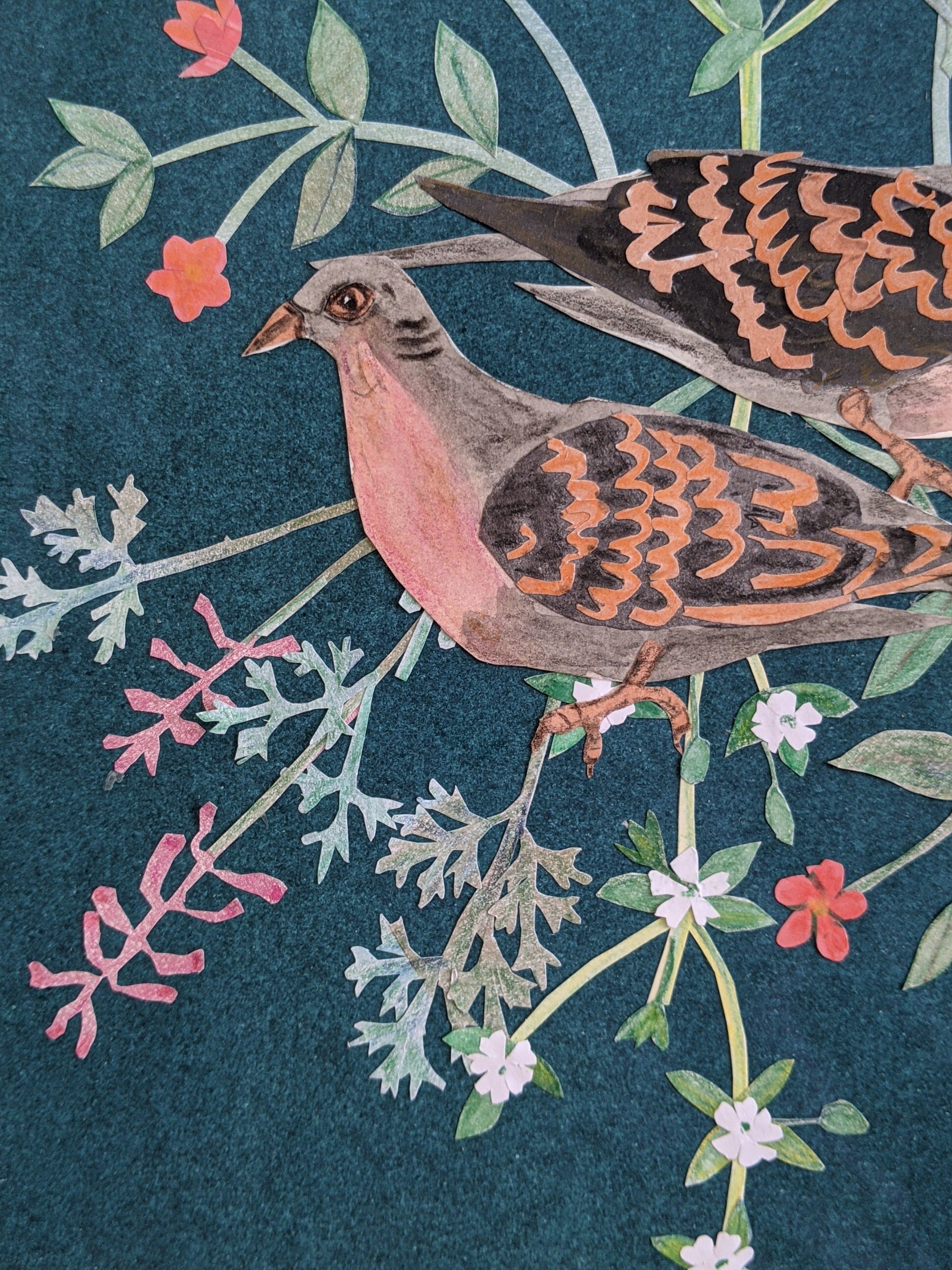 Image 1 of 6
Image 1 of 6

 Image 2 of 6
Image 2 of 6

 Image 3 of 6
Image 3 of 6

 Image 4 of 6
Image 4 of 6

 Image 5 of 6
Image 5 of 6

 Image 6 of 6
Image 6 of 6







Turtle Doves.
Collage of Gelli Plate papers and hand-painted papers.
This artwork is sold unmounted and unframed and is in my art sale!
11 cm x 26 cm
This collage is part of my Britain’s Vanishing Birds series and was created to raise awareness of these beautiful birds and the fascinating plants that they need to support their conservation.
The Turtle Dove is a small, delicate, wild dove with grey feathers blushed pink and ginger. It is also the UK’s fastest declining bird and a symbol of the extinction crisis unfolding in Britain.
In the 1960s there were 125,000 pairs in Britain, but between 1967 and 2016 their numbers plummeted by 98%.
Since the 1950s, Britain has destroyed almost all its wildflower meadows, while chemical pesticides have removed arable weeds. Turtle Doves eat mostly grains, living on wild plant and weed seeds foraged from: Scarlet Pimpernel, Chickweed, Common Fumitory which are all arable plants. Britain has also lost dense hedgerows where Turtle Doves like to nest.
UK conservation status: Red
The Turtle Dove is protected by The Wildlife and Countryside Act 1981
Collage of Gelli Plate papers and hand-painted papers.
This artwork is sold unmounted and unframed and is in my art sale!
11 cm x 26 cm
This collage is part of my Britain’s Vanishing Birds series and was created to raise awareness of these beautiful birds and the fascinating plants that they need to support their conservation.
The Turtle Dove is a small, delicate, wild dove with grey feathers blushed pink and ginger. It is also the UK’s fastest declining bird and a symbol of the extinction crisis unfolding in Britain.
In the 1960s there were 125,000 pairs in Britain, but between 1967 and 2016 their numbers plummeted by 98%.
Since the 1950s, Britain has destroyed almost all its wildflower meadows, while chemical pesticides have removed arable weeds. Turtle Doves eat mostly grains, living on wild plant and weed seeds foraged from: Scarlet Pimpernel, Chickweed, Common Fumitory which are all arable plants. Britain has also lost dense hedgerows where Turtle Doves like to nest.
UK conservation status: Red
The Turtle Dove is protected by The Wildlife and Countryside Act 1981
Collage of Gelli Plate papers and hand-painted papers.
This artwork is sold unmounted and unframed and is in my art sale!
11 cm x 26 cm
This collage is part of my Britain’s Vanishing Birds series and was created to raise awareness of these beautiful birds and the fascinating plants that they need to support their conservation.
The Turtle Dove is a small, delicate, wild dove with grey feathers blushed pink and ginger. It is also the UK’s fastest declining bird and a symbol of the extinction crisis unfolding in Britain.
In the 1960s there were 125,000 pairs in Britain, but between 1967 and 2016 their numbers plummeted by 98%.
Since the 1950s, Britain has destroyed almost all its wildflower meadows, while chemical pesticides have removed arable weeds. Turtle Doves eat mostly grains, living on wild plant and weed seeds foraged from: Scarlet Pimpernel, Chickweed, Common Fumitory which are all arable plants. Britain has also lost dense hedgerows where Turtle Doves like to nest.
UK conservation status: Red
The Turtle Dove is protected by The Wildlife and Countryside Act 1981